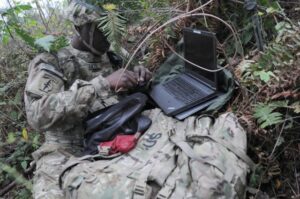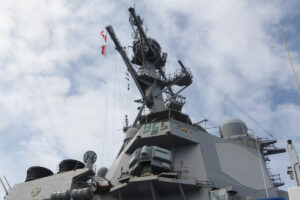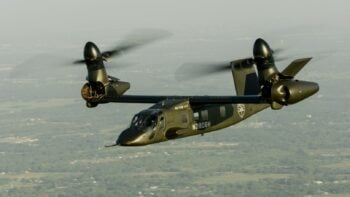
M1 tank at the National Training Center in 2015.
What will the next war look like? Robots, lasers, hypersonic missiles, and stealth aircraft figure prominently, but what matters most isn’t the technology: It’s the concepts of operation that bring them all together — just as the German blitzkrieg combined tanks, aircraft, and the radio, or the Japanese at Pearl Harbor combined aircraft and ships. 2016 saw tremendous intellectual ferment among all four armed services and in the Office of the Secretary of Defense. The emerging vision of future war is frightening — but some bold ideas are taking shape for how to win it.
[All this week we’re reprinting some of our best stories of 2016 on the biggest issues: future warfare (today), robotics & artificial intelligence, China, Russia, & the defense policies of Donald Trump.]

Miserable, Disobedient & Victorious: Gen. Milley’s Future US Soldier
“On the future battlefield, if you stay in one place longer than two or three hours, you will be dead,” Army Chief of Staff Gen. Mark Milley says. “That obviously places demands on human endurance.”
With units in constant motion far from friendly forces, “being surrounded will become the norm,” continues Milley. There will no clear front line, no secure supply lines, no big bases like Bagram or Camp Victory with chow halls, air-conditioning, and showers. With enemy drones and sensors constantly on the hunt for targets, there won’t even be time for four hours’ unbroken sleep. So, says Milley, “being seriously miserable every single minute of every day will have to become a way of life.”
[click here to read the full story]

The Next War? Trench Warfare With Smart Bombs
WASHINGTON: If you want a glimpse of future war, look back a hundred years to the bloody stalemate of the Somme, the cataclysmic battle of World War I. Instead of machineguns and artillery slaughtering soldiers in no man’s land, imagine smart weapons ravaging the air, land and sea. Instead of biplanes overhead, imagine swarming drones. Instead of the unreliable radios of 1916, with communications breakdowns throwing plans into chaos, imagine wireless networks hacked and jammed by enemies. The end result — the bodies — would look much the same.
“Like the European powers at the start of World War I, we could find ourselves tremendously unprepared,” said Tom Mahnken, president of the Center for Strategic and Budgetary Assessments. “We’re likely to find ourselves surprised, and unpleasantly surprised.”
[click here to read the full story]

Mini-Drones & Bayonets: New Marine Warfare Concept
“My goal is, at the end of next year, every deployed Marine infantry squad has their own quadcopter” for aerial recon, [Marine Corps Commandant] Neller said this morning. Maybe, he added, we can even 3D print mini-drones on demand. After all, he said, “in 10 years, we’ll be 3D printing chow.”
The audience chuckled, but Neller was only slightly tongue in cheek. “They’re already printing food — and you didn’t like the chow now,” he said to further laughter. From printing food to parts to mini-drones, he said, “it’s gonna disrupt everything we know about supply — which I think is pretty cool.”
[click here to read the full story]

Offensive Cyber In The Street Fight
Cyber war is coming to the street fight. Just weeks ago, when the Army’s 1/1 Armored Brigade conducted both live and virtual wargames against a simulated enemy, the old-school treadheads had a revolutionary new ally: offensive cyber teams, with two to three specialists from Army Cyber Command (ARCYBER).
Capabilities once restricted to national missions and strategic intelligence are now being attached to individual companies of 80-120 soldiers. In exercises, offensive teams moved up within eyeshot of the front line to attack enemy communications while the 1/1 soldiers fought the physical battle.
[click here to read the full story]

Invisible Bullets: The Navy’s Big Problem In Future War
WASHINGTON: In the brutal naval battles of the future, the first clash of arms will be a clash of electrons. If you don’t win the invisible battle of the airwaves, you can’t win the visible battle of missiles….
Today, we transmit at high power all the time. Since the Cold War ended, US forces have grown accustomed to communicating, sensing, and transmitting at will, unhindered, without regard for who might be listening. But Russia, China, and other potential adversaries are exploiting rapid advances in processing power, sometimes more quickly than the hidebound Pentagon procurement system can. Meanwhile, the Navy is only now reviving its electronic warfare expertise (and the other services are much further behind), a revival embodied in a 2014 document on electromagnetic maneuver warfare.
[click here to read the full story]

Air Force Leading Way To 3rd Offset: Bob Work
“Offset strategies are not about technology per se, so it drives me crazy when people say, ‘oh, the Third Offset is AI and autonomy,’” Work thundered. “Wrong!” Offset is about “operational and organizational constructs,” he said, which are “enabled” by new technology but not simply a matter of tech.
“The first operational organizational construct of the Third Offset is the JICSPOC, the Joint Interagency Combined Space Operations Center,” said Work. “It is designed to perform battle management and command and control of a space constellation (i.e. satellites) under threat of attack.”
[click here to read the full story]

47 Seconds From Hell: Last-Ditch Robotic Missile Defense
In a report out this morning, CSBA scholars Bryan Clark and Mark Gunzinger argue that we don’t just need new technology and new tactics to confront the growing missile threats from China and Russia, though lasers, railguns, and hypervelocity projectiles are all useful. We need a different missile defense mindset than what we have today, one that trusts computers to shoot down incoming weapons at literally the last minute…..
No human can optimally match a multitude of different weapons against a salvo of incoming targets when there’s only a minute to impact. While existing missile defense systems like the Navy’s Aegis do have an automatic mode, Clark and Gunzinger say, it isn’t sophisticated enough to handle large incoming salvos or new “non-kinetic” defenses like lasers.
[click here to read the full story]
Army wraps up FLRAA PDR, incorporating special ops design changes
According to a SOCOM official, the Army included feedback from the command that led to design changes like hardware for a refueling probe and features that will enable special operators to make unique modifications.



























